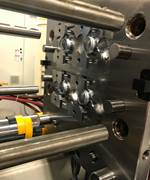
Automation for ETO moldmakers ensures highly paid engineers with unique skillsets are more productive. Photo Credit: Counterpart
The engineer-to-order (ETO) manufacturing process means engineers are continually making new and different components (as opposed to high-quantity manufacturing). For example, mold builders who produce one-of-a-kind molds require solutions designed explicitly for streamlining workflow.
When looking to streamline the engineering to production flow, new assemblies with many shared components (yet never the same) are ideal. For mold builders using CAD/CAE, integration is vital, and even more robust, if paired with product data management (PDM). Synchronizing CAD/CAE and ERP data in real-time ensures that production, purchasing and engineering are continually aligned. Failure to synchronize a fully-integrated ERP solution can introduce human error. This critical synchronicity is especially crucial because engineers continue working on updated designs.
The paradigm in ETO always comes down to what to build when, and keeping up with new engineering requests, cancellations and revisions.
Here is an example of the complexity of the engineering-focused process for a custom moldmaker:
- Project design is finalized, approved by the customer and manufactured.
- The customer requests an updated design, which requires an additional slide.
- The engineering team must know and communicate with purchasing and manufacturing what parts were changed (and stop manufacturing the older version).
- Change the design, gain approval and communicate with purchasing and manufacturing the specific added, removed and updated components, typically a manual process prone to error.
- Once a mold enters manufacturing, provide the correct version of the CAD.

An example of an automatic file attachment provided by CAD/CAE software with PDM, which identifies files that need adjustment.
This approach demonstrates the hours of duplicate data entry for engineers, resulting in a considerable waste of time and possible production disruptions due to revision discrepancies. Mold engineers using CAD/CAE alone are challenged to create and maintain ERP data. Effective integration of ERP into CAD/CAE software is vital. Data integration allows engineers to drill into the bill of materials (BOMs) and item level discrepancies for each model.
Automation for ETO moldmakers ensures highly paid engineers with unique skillsets are more productive. Contemporary ETO ERP solutions reduce the routine work so that experienced engineers design better molds and quote more business. Automating nonvalue-added functions guarantees increased productivity and profits.
Related Content
-
Leading Mold Manufacturers Share Best Practices for Improving Efficiency
Precise Tooling Solutions, X-Cell Tool and Mold, M&M Tool and Mold, Ameritech Die & Mold, and Cavalier Tool & Manufacturing, sit down for a fast-paced Q&A focused on strategies for improving efficiencies across their operations.
-
How to Fix Predicted Warpage Before It Happens with Windage and CAD Model Morphing
Applying windage and model-morphing techniques saved toolmaker/molder Sturgis Molded Products the time, cost, headaches of multiple part/mold design iteration loops, cumbersome cooling fixtures, and long molding cycles.
-
Tips for Tackling Mold Design, Machining, Cutting Tool and Wear Challenges
Tips for tasks ranging from reducing risk in part design and taking advantage of five-axis machining to refining cutting tool performance and reducing wear with guiding and centering systems.








.jpg;maxWidth=300;quality=90)







.jpg;maxWidth=970;quality=90)